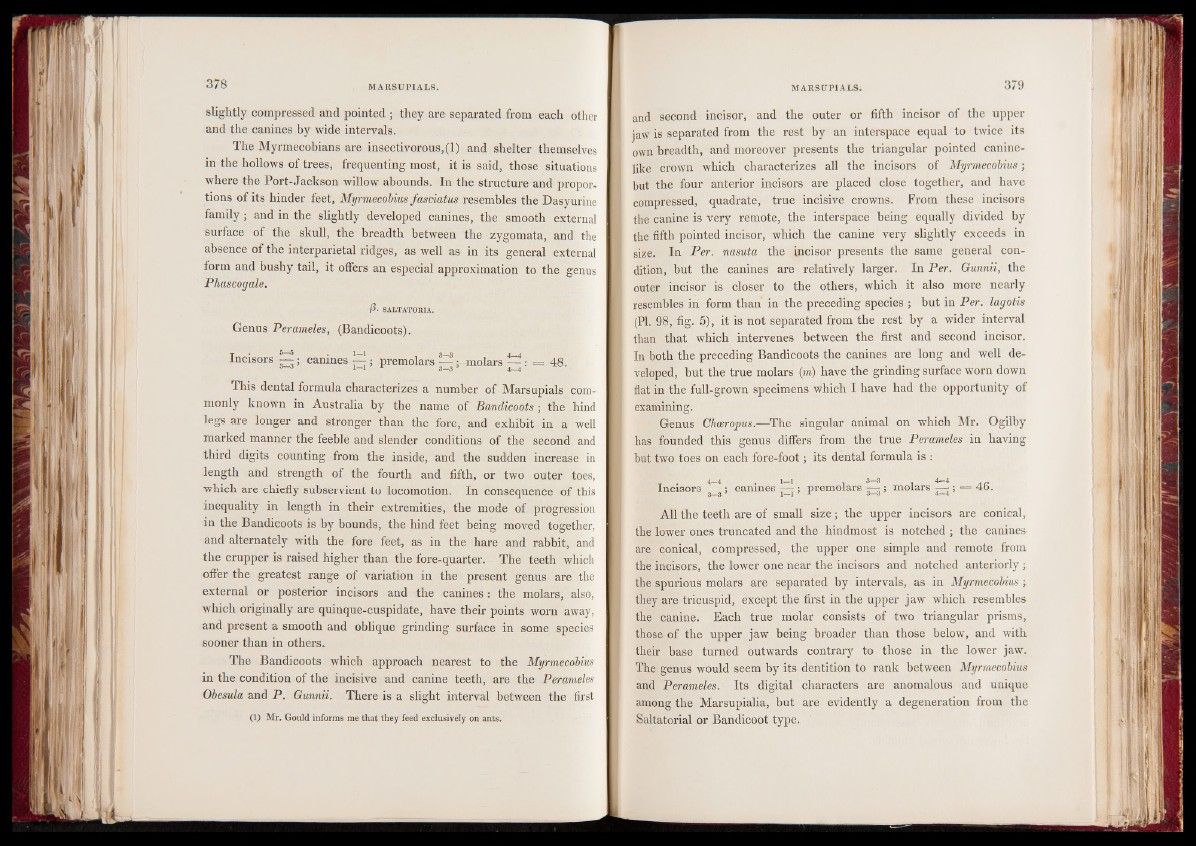
slightly compressed and pointed ; they are separated from each other
and the canines by wide intervals.
The Myrmecobians are insectivorous, (1) and shelter themselves
in the hollows of trees, frequenting most, it is said, those situations
where the Port-Jackson willow abounds. In the structure and proportions
of its hinder feet, Myrmecobius fasdatus resembles the Dasyurine
family; and in the slightly developed canines, the smooth external
surface of the skull, the breadth between the zygomata, and the
absence of the interparietal ridges, as well as in its general external
form and bushy tail, it offers an especial approximation to the genus
Phascogale.
P - SALTATORIA.
Genus Perameles, (Bandicoots).
Incisors — ; canines — ; premolars ^ ; molars — : = 48.
This dental formula characterizes a number of Marsupials commonly
known in Australia by the name of Bandicoots • the hind
legs are longer and stronger than the fore, and exhibit in a well
marked manner the feeble and slender conditions of the second and
third digits counting from the inside, and the sudden increase in
length and strength of the fourth and fifth, or two outer toes,
which are chiefly subservient to locomotion. In consequence of this
inequality in length in their extremities, the mode of progression
in the Bandicoots is by bounds, the hind feet being moved together,
and alternately with the fore feet, as in the hare and rabbit, and
the crupper is raised higher than the fore-quarter. The teeth which
offer the greatest range of variation in the present genus are the
external or posterior incisors and the canines: the molars, also,
which originally are quinque-cuspidate, have their points worn away,
and present a smooth and oblique grinding surface in some species
sooner than in others.
The Bandicoots which approach nearest to the Myrmecobius
in the condition of the incisive and canine teeth, are the Perameles
Obesula and P. Gunnii. There is a slight interval between the first
(1) Mr. Gould informs me that they feed exclusively on ants.
and second incisor, and the outer or fifth incisor of the upper
jaw is separated from the rest by an interspace equal to twice its
own breadth, and moreover presents the triangular pointed caninelike
crown which characterizes all the incisors of Myrmecobius;
but the four anterior incisors are placed close together, and have
compressed, quadrate, true incisive crowns. From these incisors
the canine is very remote, the interspace being equally divided by
the fifth pointed incisor, which the canine very slightly exceeds in
size. In Per. nasuta the incisor presents the same general condition,
but the canines are relatively larger. In Per. Gunnii, the
outer incisor is closer to the others, which it also more nearly
resembles in form than in the preceding species ; but in Per. lagotis
(PL 98, fig. 5), it is not separated from the rest by a wider interval
than that which intervenes between the first and second incisor.
In both the preceding Bandicoots the canines are long and well developed,
but the true molars (m) have the grinding surface worn down
flat in the full-grown specimens which I have had the opportunity of
examining.
Genus Chceropus.—The singular animal on which Mr. Ogilby
has founded this genus differs from the true Perameles in having
but two toes on each fore-foot; its dental formula is :
Incisors ^; canines ^ ; premolars — ; molars — 46.
All the teeth are of small size; the upper incisors are conical,
the lower ones truncated and the hindmost is notched ; the canines-
are conical, compressed, the upper one simple and remote from
the incisors, the lower one near the incisors and notched anteriorly ;
the spurious molars are separated by intervals, as in Myrmecobius ;
they are tricuspid, except the first in the upper jaw which resembles
the canine. Each true molar consists of two triangular prisms,
those of the upper jaw being broader than those below, and with
their base turned outwards contrary to those in the lower jaw.
The genus would seem by its dentition to rank between Myrmecobius
and Perameles. Its digital characters are anomalous and unique
among the Marsupialia, but are evidently a degeneration from the
Saltatorial or Bandicoot type.